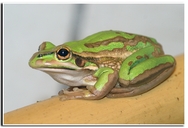|
Litoria aurea (Lesson, 1830)
Green and Golden Bell Frog | family: Hylidae subfamily: Pelodryadinae genus: Litoria |
|
Taxonomic Notes: Following the Australian Society of Herpetology, AmphibiaWeb uses Litoria instead of Ranoidea or Dryopsophus (contrary to Dubois and Fretey 2016 and Duellman et al 2016). |
|
 © 2008 Henk Wallays (1 of 11) |
|
|
|
Description Reproductively mature males have thumbs that are swollen through the development of nuptial pads (Pyke 1999). Distribution and Habitat Country distribution from AmphibiaWeb's database: Australia. Introduced: New Caledonia, New Zealand, Vanuatu.
Prefers freshwater habitat, where the water bodies are still, shallow, unshaded, ephemeral, and unpolluted (Pyke and White 1996). Inhabited water bodies are generally isolated and free of native fish species. Individuals disperse and forage over large areas, and diverse terrestrial habitats. Emergent aquatic vegetation, such as reeds and rushes, furnish foraging and basking habitat, and nearby grassy areas provide the principal feeding ground (Pyke 1999). Life History, Abundance, Activity, and Special Behaviors Their deep growling call has been described as a slow gutteral four-part 'craw-awk, crawk, crok, crok' (Cogger 1996). Larva Tadpole diet includes bacteria, algae and organic detritus, while adult frogs feed on almost anything, including insects and other frogs (Pyke 1990). In short, the frogs are a voracious, cannibalistic species. Trends and Threats The most probable causes for decline include habitat fragmentation, drainage alteration, and the introduction of predatory fish. A number of studies have shown correlation between L. aurea declines and the increasing distribution of Gambusia holbrooki (the "Mosquito Fish"), a native to North America that was introduced to control mosquito larvae. Morgan and Buttemer (1996) conducted laboratory experiments which demonstrated the high susceptibility of L. aurea tadpoles to predation by G. holbrooki, particularly small, newly hatched tadpoles. UVB experimentation (van de Mortel and Buttemer 1996) has not demonstrated any significant susceptibility of L. aurea to radiation exposure. Possible reasons for amphibian decline General habitat alteration and loss Comments In amphibian conservation, particularly in when it comes to the threat of disease, it’s often difficult to come up with practical solutions. However, new research from Australia (Waddle et al 2024) has tested an innovative method to help protect frogs from chytridiomycosis, a potentially deadly disease caused by the fungus Batrachochytrium dendrobatidis (Bd). This fungus thrives in cool conditions and is responsible for amphibian population declines and extinctions worldwide. Waddle and colleagues created "frog saunas" by using simple shelters made of bricks and plastic sheeting to create warm environments where the endangered Green and Golden Bell Frog (Litoria aurea) could raise their body temperatures above that favoured by the fungus. Remarkably, their experiments showed that infected frogs actually gravitated toward warmer areas and were able to fend off infections more effectively, even developing resistance to future infections! Cheap and easy to make, "frog saunas" can be deployed by scientists and the general public alike, and may be a practical conservation action to help conserve amphibians in the face of disease. (Written by Jodi Rowley)
References
Barker, J., Grigg, G. C., and Tyler, M. J. (1995). A Field Guide to Australian Frogs. Surrey Beatty and Sons, New South Wales. Cogger, H. G. (1996). Reptiles and Amphibians of Australia. Reed Books Australia, Port Melbourne. Medway, L. and Marshall, A. G. (1975). ''Terrestrial vertebrates of the New Hebrides: origin and distribution.'' Philosphical Transactions of the Royal Society of London. Series B., 272, 423-65. Morgan, L. A., and Buttemer, W. A. (1996). ''Predation by the non-native fish Gambusia holbrooki on small Litoria aurea and L. dentata tadpoles.'' Australian Zoologist, 30(2), 143-149. Pyke, G. H. (1999). ''Green and Golden Bell Frog.'' Nature Australia, 26(4), 50-59. Pyke, G. H. and White, A. W. (1996). "Habitat requirements for the Green and Golden Bell Frog Litoria aurea (Anura: Hylidae)." Australian Zoologist, 30(2), 224-232. [link] Van De Mortel, T. F., and Buttemer, W. A. (1996). ''Are Litoria aurea eggs more sensitive to ultraviolet-B radiation than eggs of sympatric L. peronii or L. dentata?'' Australian Zoologist, 30(2), 150-157. White, A. W. and Pyke, G. H. (1996). "Distribution and conservation status of the Green and Golden Bell Frog Litoria aurea in New South Wales." Australian Zoologist, 30(2), 177-189. [link] Originally submitted by: Jean-Marc Hero et. al. (first posted 1999-05-06) Edited by: Kellie Whittaker, Michelle S. Koo (2024-08-11) Species Account Citation: AmphibiaWeb 2024 Litoria aurea: Green and Golden Bell Frog <https://amphibiaweb.org/species/1219> University of California, Berkeley, CA, USA. Accessed Jun 8, 2025.
Feedback or comments about this page.
Citation: AmphibiaWeb. 2025. <https://amphibiaweb.org> University of California, Berkeley, CA, USA. Accessed 8 Jun 2025. AmphibiaWeb's policy on data use. |



 Map of Life
Map of Life